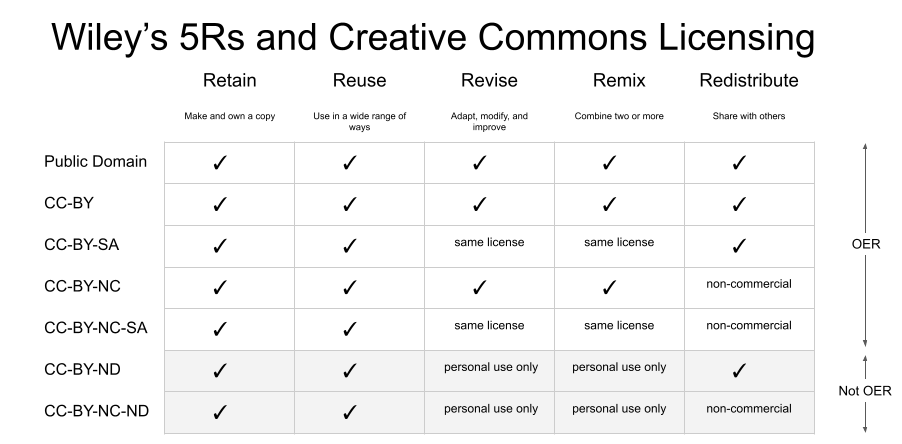3 OER Licensing + Creative Commons
Canadian Copyright Act
Under the Canadian Copyright Act, the creator of any work is provided the sole right to produce or reproduce that work. The copyright term is limited to the life of the creator plus fifty (soon to be seventy under USMCA) years after his/her death. Once this term has ended, the work enters the public domain.
OER bypass traditional copyright restraints by using open licensing systems, such as Creative Commons.
Creative Commons Licensing
The Creative Commons is an “open” license that allows others to reuse, adapt, and re-publish content. CC allows creators to explain, in plain language, how their works can be used by the broader community.
The Four Components of Creative Commons Licenses
Creative Commons licenses are based on the following four components:
These elements are combined to create a total of six creative commons licenses, all of which can be viewed on the Creative Commons website.
Example Licence Option:
 CC-BY-SA: This license allows reusers to distribute, remix, adapt, and build upon the material in any medium or format, so long as attribution is given to the creator. The license allows for commercial use. If you remix, adapt, or build upon the material, you must license the modified material under identical terms.
CC-BY-SA: This license allows reusers to distribute, remix, adapt, and build upon the material in any medium or format, so long as attribution is given to the creator. The license allows for commercial use. If you remix, adapt, or build upon the material, you must license the modified material under identical terms.
NOTE: The No Derivative Works and Share Alike elements are incompatible and cannot be combined under one license.
Public Domain

Creators can also choose to donate their work to the public domain using a CC0 licence. Material under this licence does not have any restrictions, not even attribution.
Attribution and Referencing
When using OER it’s important to provide proper attribution to the original creator of the work. Creative Commons has an online guide that demonstrates proper and improper attribution, providing attribution for multiple resources, as well as each component of the attribution.
Attribution Example

“Sleeping Kitten” by pedram navid is licensed under CC BY-NC-SA 2.0
You may be wondering about the difference between attribution and citation. One key difference is the purpose behind each; citation serves both academic and legal purposes whereas attribution satisfies a legal requirement. BCCampus has created a helpful guide to outline the nuances between attribution and citation.
Choosing a Creative Commons Licence for Your OER
Choosing a Creative Commons license can be confusing at first. Thankfully, the organization has created an online tool that will help you choose your license. The tool will also generate HTML code that you can embed in your OER.
Example Generated Licence

This work is licensed under a Creative Commons Attribution-NonCommercial 4.0 International License.
This graphic demonstrations where each Creative Commons licence falls on the OER spectrum according to the 5Rs of OER:
“Wileys 5Rs and Creative Commons Licensing” by Krysta McNutt is licenced under CC-BY 4.0
(to view the full version, click here)
Other Open Licenses
While the Creative Commons is the most ubiquitous of the open licensing platforms, there are alternatives such as the GNU General Public License (from the Free Software Foundation) and the MIT License (from Massachusetts Institute of Technology).
Attribution
This chapter was adapted from The ABOER Starter Kit by Erik Christiansen and Krysta McNutt, Faculty of Education, University of Alberta, under a Creative Commons Attribution 4.0 International License (CC-BY 4.0).



Feedback/Errata